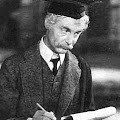
"Ernst Haeckel had a checkered scientific career. With an M.D. from the University of Berlin, a professorship in zoology at the University of Jena, and directorship of its Zoological Institute, Haeckel became the preeminent proponent of Darwinism in Germany. He was praised by Darwin himself in a letter sent to him, dated December 27, 1871: "I shall continue to work as long as I can "but when I stop there are so many good men fully capable of carrying on our work and of these you rank as the first." Haeckel's major tomes on general morphology, The Natural History of Creation, and Systematic Phylogeny, gained him world recognition. He was a member of more than 90 learned societies, including the American Philosophical Society, the Lincean Academy in Rome and the Royal Academies of Edinburgh, Bologna, and Sweden. One of his greatest honors was his selection as consultant to the Challenger Expedition (1873-1876), established by the British Admiralty as the first non-commercial exploration of the deep-sea environment. It was the expedition that established the field of oceanography. Haeckel was among the most eminent zoologists chosen to write reports of the findings. Given all these honors where did he go wrong?
Haeckel's interest in metaphysics intersected with his commitment to evolutionary theory. He espoused a belief system that maintained that all of nature was subject to identical rules of evolution (monism). Every creature climbed his own family tree in the same order. To prove this hypothesis, Haeckel produced illustrations of the embryos of a human, chicken, and salamander that "documented" their identical biological origin and structure. He was called on the professional carpet, confessed to fraud, and his reputation suffered severely. Creationists had a field day. Thus, despite Haeckel's important contributions to the fields of biology, taxonomy, and ecology, his reputation in the field of art remains unsullied.
His watercolors and drawings, made during his sojourn in Ceylon (Travel Pictures) and on his scientific journeys (Art Forms in Nature), are landmarks in the field of naturalist illustration, although many would not pass strict scientific muster. Indeed, much of naturalist illustration is not natural at all but permits stylization and distortion for decorative effect. Haeckel aimed Art Forms in Nature at a broad audience rather than specialists. Each of the 100 plates was accompanied by a short, readable commentary that made biological concepts accessible to the public. Moreover Haeckel's use of Art Nouveau techniques made the book even more appealing and "fashionable." The publication was an immediate success and remains a treasure to this day."
from mblwhoilibrary.org















some inspiration for easter eg painting as well :D :D
ReplyDeleteha ha!
ReplyDelete